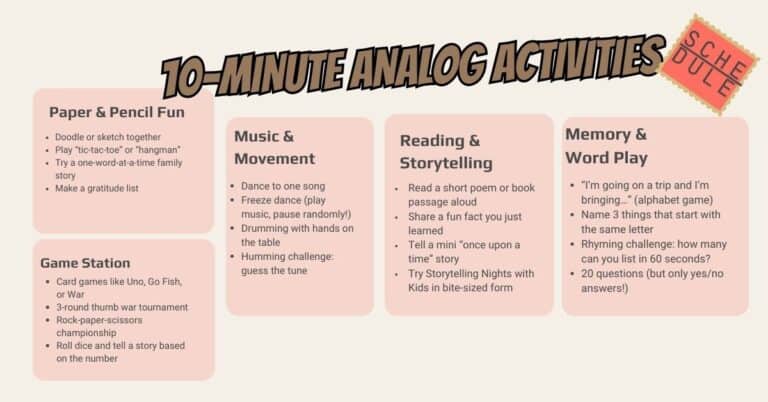What This Guide Covers
This in-depth pillar post is all about balancing family time while still making room for school and hobbies. You’ll get time-tested strategies, flexible routines, and actionable advice that helps both parents and kids feel more connected and less overwhelmed.
We’ll cover:
- Family planning tips and how to involve your kids
- Managing schedules without burnout
- Creating meaningful family time—even on weekdays
- Teaching your child the value of balance early on
- Time management tools that really work
Let’s dive into the nitty-gritty of creating a balanced, happy family life.

1. Prioritize and Plan as a Family
Life is hectic, but a well-structured plan makes all the difference. Sit down as a family and discuss priorities. What activities are non-negotiable? What can be adjusted? Create a weekly schedule that includes school, hobbies, and dedicated family time. A visual planner or a shared digital calendar can keep everyone on track.
Pro tip: Build in some buffer time for rest and relaxation—kids need downtime just as much as adults do.
2. Set Realistic Expectations
We all want our kids to be well-rounded, but overloading them with activities can lead to stress and burnout. Encourage hobbies that genuinely spark their interest rather than filling their schedule with too many commitments.
Balancing family time means making conscious choices to prioritize interactions that matter most.Remember, balancing family time also includes moments of relaxation together.
If you feel your child is struggling to keep up with schoolwork and extracurriculars, reassess and cut back if needed. Balance means ensuring they have time to enjoy childhood, not just chase achievements.
3. Planned Balancing Family Time
Amidst all the hustle, don’t let family time take a backseat. Make it a priority by scheduling regular family dinners, weekend outings, or even simple nightly check-ins. These moments help children feel connected and supported, reducing stress from their busy routines.
Easy ideas for quality time:
Always remind yourself of the importance of balancing family time amidst your busy schedule.
- Cooking dinner together
- Movie nights with homemade popcorn
- A short evening walk or a game night
- Sunday breakfast traditions
4. Make Homework Less Stressful
Homework battles are real! Set up a dedicated study space free from distractions and establish a consistent routine. Encourage breaks and avoid last-minute cramming by setting aside specific times for schoolwork.
If your child struggles with assignments, offer help but don’t take over. Teaching them how to manage their workload and time will benefit them in the long run.
5. Teach Time Management Early
Help your child learn the basics of time management. Using timers, to-do lists, or simple planners can give them a sense of control over their day. Let them take small steps in organizing their time, making them more independent and responsible.
6. Lead by Example
Children mirror their parents’ habits. If they see you prioritizing work-life balance, taking breaks, and enjoying family time, they’ll naturally pick up on it. Show them that while school and hobbies are important, so is spending time with loved ones.
7. Be Flexible and Embrace Imperfection
No schedule is foolproof, and that’s okay! Life happens—unexpected school projects, late work meetings, or a sick day can throw plans off track. The key is to be adaptable and not stress over minor disruptions. Remember, the goal isn’t perfection but a rhythm that works for your family.
Effective balancing family time promotes not just efficiency but also emotional well-being.
Final Thoughts
Tips for Balancing Family Time
Being mindful of balancing family time helps teach children to value relationships over tasks. Family time is an ongoing process that requires adjustments along the way. Prioritize what matters most, stay flexible, and cherish the small moments together. Your child may not remember every homework assignment or piano lesson, but they will remember the love, laughter, and time spent with you.
FAQs
1. How do I help my child manage their time effectively?
Encourage the use of planners, to-do lists, or time-blocking methods to help them structure their day and balance responsibilities.
Strive for a balance where balancing family time enhances all members’ quality of life.
2. How many extracurricular activities are too many?
It depends on your child’s interests and energy levels. Ideally, they should have free time to relax and enjoy unstructured play.
3. What should I do if my child struggles with school and hobbies?
Reassess their schedule and consider reducing commitments. Prioritize school while keeping at least one activity they genuinely enjoy.
4. How can I make family time more meaningful?
Engage in activities that everyone enjoys, such as cooking, movie nights, or outdoor adventures. Keep distractions like phones and work away during this time.
5. What if my child prefers screen time over other activities?
Set limits on screen time and encourage balance by introducing hobbies they might enjoy, such as art, music, or sports.



